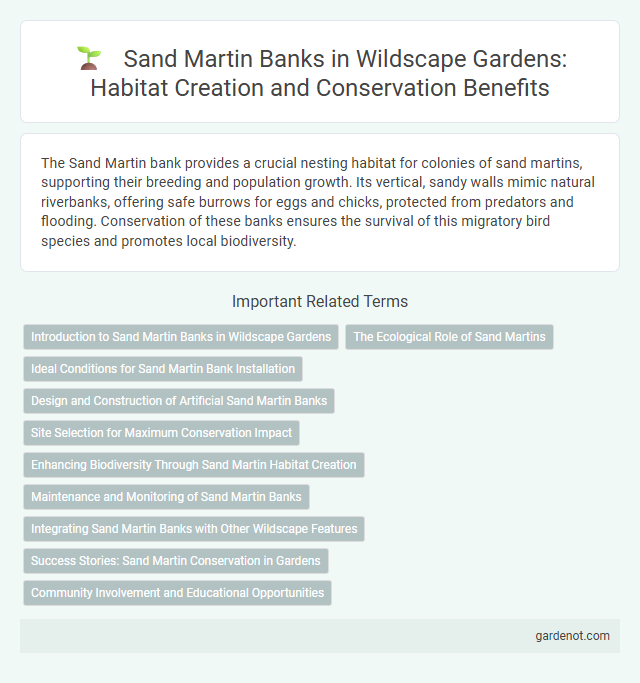The Sand Martin bank provides a crucial nesting habitat for colonies of sand martins, supporting their breeding and population growth. Its vertical, sandy walls mimic natural riverbanks, offering safe burrows for eggs and chicks, protected from predators and flooding. Conservation of these banks ensures the survival of this migratory bird species and promotes local biodiversity.
Introduction to Sand Martin Banks in Wildscape Gardens
Sand martin banks in Wildscape Gardens provide essential nesting habitats for sand martins, a migratory bird species known for their distinctive burrow nests. These banks are carefully designed with sandy soil and gentle slopes to mimic natural environments, encouraging breeding and population growth. Protecting and maintaining these habitats supports biodiversity and enhances the overall ecological health of Wildscape Gardens.
The Ecological Role of Sand Martins
Sand martin banks provide essential breeding habitats for these migratory birds, supporting their population stability across various regions. These banks contribute to ecosystem health by controlling insect populations, acting as natural pest regulators. Their nesting behavior also influences soil aeration and nutrient cycling, promoting biodiversity in riparian environments.
Ideal Conditions for Sand Martin Bank Installation
Sand martin bank installation thrives in well-drained sandy or loamy soil with a gentle slope between 30 to 45 degrees to facilitate natural burrowing behavior. Ideal sites feature proximity to water sources such as rivers or lakes, providing ample insect prey essential for sand martin sustenance. Adequate sunlight exposure and minimal vegetation cover ensure optimal temperature regulation and predator visibility for successful breeding.
Design and Construction of Artificial Sand Martin Banks
The design of artificial sand martin banks involves creating vertical or near-vertical sandy faces that mimic natural riverbank habitats, optimizing the substrate texture and moisture levels to encourage nesting. Construction requires selecting stable, erosion-resistant sites with adequate drainage to prevent collapse, often incorporating layered sand and clay to replicate natural burrowing conditions. Proper orientation away from prevailing winds and predators also enhances breeding success by providing secure, temperature-regulated nesting chambers.
Site Selection for Maximum Conservation Impact
Choosing a site with abundant vertical sandy banks near slow-flowing water bodies is critical for establishing a successful Sand martin bank. Optimal locations are characterized by stable, erosion-prone substrates that allow natural burrow excavation while minimizing disturbance from predators and human activity. Incorporating proximity to insect-rich foraging habitats enhances breeding success and long-term population sustainability.
Enhancing Biodiversity Through Sand Martin Habitat Creation
Creating sand martin banks significantly enhances biodiversity by providing essential nesting sites for sand martins (Riparia riparia), a species reliant on sandy riverbanks for breeding. These artificial banks support population stability and attract other wildlife, contributing to a balanced ecosystem within wildscapes. Effective habitat creation promotes ecological connectivity and fosters increased species diversity in riparian environments.
Maintenance and Monitoring of Sand Martin Banks
Regular maintenance of sand martin banks involves clearing vegetation and reinforcing bank stability to prevent erosion and collapse. Monitoring includes inspecting nest holes for occupancy rates, predation signs, and structural integrity throughout the breeding season. Data collected supports habitat management strategies to enhance nesting success and population sustainability.
Integrating Sand Martin Banks with Other Wildscape Features
Integrating Sand Martin Banks with other Wildscape features enhances habitat connectivity and supports diverse wildlife populations. Creating adjacent wetlands and native vegetation buffers improves insect availability, essential for Sand Martin feeding, while maintaining undisturbed banks encourages successful breeding. Strategic placement near water bodies and incorporating erosion control techniques promote bank stability and long-term colony sustainability.
Success Stories: Sand Martin Conservation in Gardens
Sand martin conservation in gardens has shown remarkable success by creating artificial sand martin banks that mimic natural habitats, encouraging breeding and population growth. These banks provide essential nesting sites free from predation and environmental disturbances, improving hatchling survival rates. Community-led initiatives planting native vegetation around these banks enhance foraging opportunities, further boosting local sand martin numbers.
Community Involvement and Educational Opportunities
The Sand Martin bank at Wildscape provides critical habitat for nesting sand martins, fostering strong community involvement through volunteer-led maintenance and monitoring programs. Educational opportunities abound with guided tours and interactive workshops designed to teach local schools and visitors about sand martin behavior, habitat requirements, and conservation efforts. These initiatives enhance public awareness and promote active stewardship of this unique riverbank ecosystem.
Sand martin bank Infographic

 gardenot.com
gardenot.com